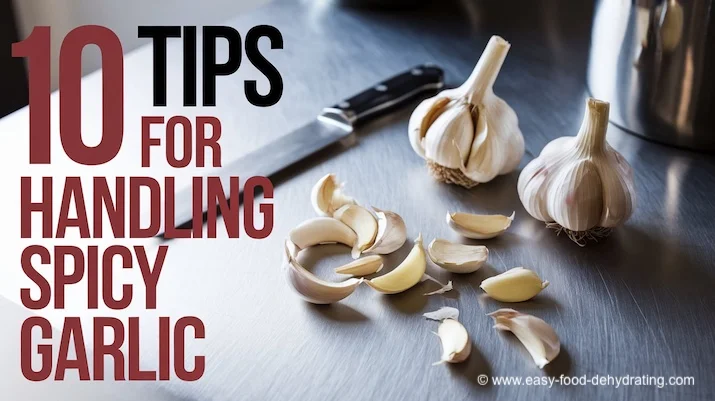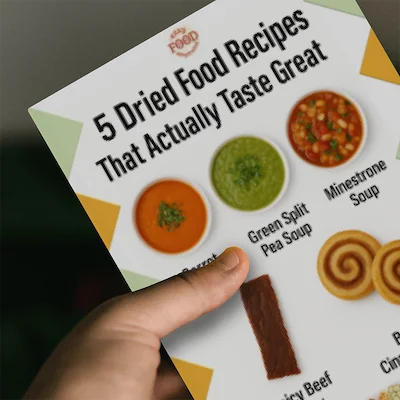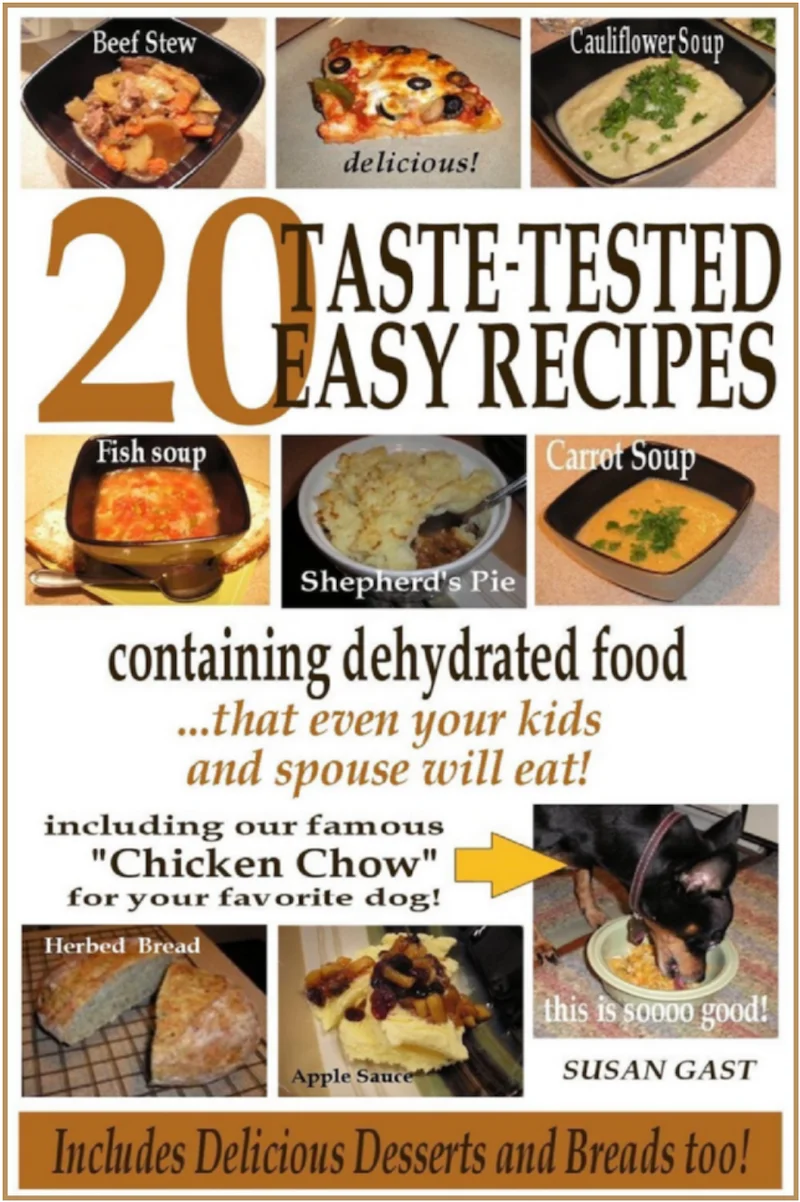What We Mean by “Dehydrate”
Here at Easy Food Dehydrating, “dehydrate” always means using an electric food dehydrator — the easy, reliable way to dry food at home.
- Home
- How to Dehydrate Garlic
- Handling Spicy Garlic Safely Tips - The Right Gear & Storage
10 Tips for Handling Spicy Garlic:
A Food Safety Guide

Garlic adds incredible flavor to meals, but spicy garlic can be tricky to handle. Its potent oils can sting your skin, leave a lingering odor, and even cause irritation if not managed correctly.
✅ Quick Answer: How do you safely handle spicy garlic?
To safely handle spicy garlic, wear protective gloves, use non-porous cutting boards, and wash hands with stainless steel and pH-neutral soap afterward. These steps prevent irritation and keep strong garlic odors from lingering on your skin.
The good news? With the right techniques, you can prep garlic safely, protect your hands, and still enjoy every clove without worry.

Tip regarding eating garlic: Share the meal with your partner so there will be zero complaints about garlic breath!
Here are my top ten tips to managing potent garlic safely, and effectively.
1. Best Gloves for Safe Garlic Handling
Don't just grab any gloves – choose strategically when handling garlic bulbs. Even though their 15 mil thickness might sound a bit like overkill, it isn't. Just get a pair that fit well because you don't want to be chopping off the tip of an oversized glove, right?
BEST CHOICE: Long rubber kitchen gloves
- Look for elbow-length options
- Choose textured palms for better grip
- Ensure they're chemical-resistant
- Check thickness (minimum 15 mil recommended)
ALTERNATIVE: Heavy-duty nitrile gloves
- Always double-layer when using nitrile
- Choose powder-free options
- Select minimum 8 mil thickness
- Replace immediately if compromised
AVOID: Latex gloves (can cause allergic reactions)
- Thin food service gloves
- Worn or damaged gloves
- Loose-fitting protection
Steer clear of latex gloves as they're a bit on the flimsy side and don't deter garlic's pungent odor, or its stinging effect for some folks.
🧄 🧄 🧄 🧄 🧄
2. How to Spot Garlic Reactions Early
Understanding your body's reactions is crucial. If you feel your hands swelling or get a rash when NOT wearing gloves - wear gloves!
IMMEDIATE REACTIONS TO BE ON THE LOOKOUT FOR:
- Burning or tingling sensations
- Skin redness or irritation
- Itching or rash development
- Unusual warmth in handled areas
DELAYED REACTIONS:
- Skin sensitivity
- Persistent odor on skin
- Lingering discomfort
- Changes in skin texture
WHEN TO SEEK MEDICAL ATTENTION:
- Severe burning sensation
- Persistent rash or hives
- Difficulty breathing
- Swelling of hands or face
Gloves obviously act as an odor-barrier as you don't want your hands to smell like last Tuesday's dinner... all week.
🧄 🧄 🧄 🧄 🧄
3. Essential Tools That Make Garlic Prep Easier
The right tools make all the difference: high-carbon steel knives that maintain their edge through countless cloves, non-porous cutting boards that won't trap odors, and stainless steel bowls that resist both staining and lingering aromas.
PROTECTIVE GEAR:
- Commercial-grade gloves
- Dedicated garlic-handling apron
- Eye protection for large batches
- Sleeve protectors
PROCESSING TOOLS:
- High-carbon steel knives
- Non-porous cutting boards
- Stainless steel bowls
- Dedicated garlic container set
MAINTENANCE SUPPLIES:
- Glove sanitizer
- Tool cleaning solutions
- Equipment storage containers
- Replacement parts
Your tools matter as much as your technique. But it's not just about having the right equipment - it's about maintaining it properly with dedicated sanitizers, cleaning solutions, and proper storage containers.
🧄 🧄 🧄 🧄 🧄
4. Prepping Garlic the Right Way Before You Chop
Set yourself up for success! First, check the garlic bulbs and remove the loose papery skin, trim the root ends, and sort the cloves by size.Discard damaged bulbs.
GARLIC PREPARATION:
- Remove loose papery skin
- Trim root ends
- Sort by size for batch processing
- Discard any damaged cloves
WORKSPACE SETUP:
- Clean and sanitize all surfaces
- Lay out all tools before starting
- Prepare cleaning supplies
- Set up disposal container
ENVIRONMENTAL CONTROLS:
- Check ventilation
- Adjust room temperature
- Position fans if needed
- Ensure adequate lighting
Make sure you can see what you're doing - work beneath good lighting!
🧄 🧄 🧄 🧄 🧄
5. Smart Gadgets That Cut Down Garlic Contact
Minimize direct contact with these helpful tips. I have a great garlic press for fresh bulbs and it's stainless steel. So what? Well after a quick wash, there's never any residual garlic odor on it!
MANUAL TOOLS:
- Garlic press (spring-loaded preferred)
- Garlic rocker with cleaning brush
- Silicone garlic peeler tubes
- Multi-blade garlic slicer
ELECTRIC OPTIONS:
- Food processor with garlic attachment
- Electric mini-chopper
- Garlic grinding attachment
- High-speed blender
SPECIALTY ITEMS:
- Garlic scoring tool
- Garlic storage containers
- Measurement guides
- Portion control tools
There are electric options if you don't have strong hands to crush the garlic in a press. I prefer a manual crusher so there's no plastic involved, like if you use a food processor. Having said that, if your food processor's container is made of glass, go for it!
🧄 🧄 🧄 🧄 🧄
6. The Stainless Steel Trick to Remove Garlic Smell
If you don't want to use gloves, here's how to combat lingering garlic odors: Begin by rubbing hands thoroughly against a stainless steel surface or using a dedicated odor-removing bar, focusing on fingertips and palms with circular motions for at least 30 seconds.
IMMEDIATE TREATMENT:
- Rub hands on stainless steel sink
- Use dedicated odor-removing bar
- Apply circular motion for 30 seconds
- Focus on fingertips and palms
FOLLOW-UP CARE:
- Wash with cool water
- Use pH-neutral soap
- Pat dry thoroughly
- Apply hand cream
PREVENTION METHODS:
- Pre-treat hands with oil
- Use stainless steel tools
- Maintain regular cleaning
- Replace worn equipment
This process should be immediately followed by washing hands in cool water with a pH-neutral soap, then patting them completely dry before applying a nourishing hand cream.
🧄 🧄 🧄 🧄 🧄
7. Garlic Storage Secrets: Keep It Fresh & Odor-Free
Effective garlic storage combines proper temperature control with appropriate containment methods.
FREEZER STORAGE:
- Pre-peel and flash freeze
- Store in vacuum-sealed bags
- Maintain at 0°F ~ See our Fahrenheit to Celsius converter here
- Label with date and quantity
CONTAINER OPTIONS:
- Glass containers (Mason jars) with tight seals
- Stainless steel containers
- Vacuum-sealer bags
- Mesh bags for whole bulbs
ORGANIZATION SYSTEM:
- Clear labeling system
- First-in-first-out rotation
- Inventory tracking
- Regular quality checks
Store garlic in vacuum-sealed bags, or store in airtight glass or stainless steel containers. Don't forget to add the date on the label and rotate your stock!
🧄 🧄 🧄 🧄 🧄
8. Setting Up the Perfect Garlic-Handling Workspace
Create an ideal workspace! A well-optimized garlic processing environment requires proper ventilation either through open windows or strategically placed fans - and run your AC!
VENTILATION REQUIREMENTS:
- Open windows when possible
- Use exhaust fans
- Position portable fans
- Create cross-ventilation
TEMPERATURE CONTROL:
- Maintain 65-75°F ~ See our Fahrenheit to Celsius converter here
- Avoid direct sunlight
- Monitor humidity levels
- Ensure consistent airflow
WORKSPACE LAYOUT:
- Designate clean/dirty areas
- Establish workflow zones
- Position tools efficiently
- Plan escape routes
Keep you and your garlic out of direct sunlight. The workspace should feature distinct clean and dirty zones, have tools within easy reach, and clear workflow paths.
🧄 🧄 🧄 🧄 🧄
9. Safety Precautions Everyone Should Take with Garlic
Protect yourself and others. Safety measures for garlic processing require having first aid supplies and eye wash stations. Have backup gloves, eye-wear, and masks when needed.
EMERGENCY PREPAREDNESS:
- First aid kit location
- Eye wash station
- Emergency contacts
- Incident report forms
PERSONAL PROTECTION:
- Secondary glove pairs
- Protective eye-wear
- Breathing masks if needed
- Appropriate footwear
DOCUMENTATION:
- Processing procedures
- Safety protocols
- Incident records
- Equipment maintenance logs
I'm sorry this sounds like we're handling a bomb or something, but reactions to garlic differs from person to person!
🧄 🧄 🧄 🧄 🧄
10. Post-Garlic Care: Protect Your Hands & Tools
Take care of your hands. Proper post-garlic handling is simply a two-stage hand washing process with lukewarm water and pH-balanced soap, followed by immediate moisturizing and skin barrier application.
CLEANING PROTOCOL:
- Two-stage hand washing
- Use lukewarm water
- pH-balanced soap
- Thorough drying
SKIN CARE:
- Apply moisturizer immediately
- Use skin barrier cream
- Monitor for irritation
- Allow recovery time
EQUIPMENT CARE:
- Clean all tools thoroughly
- Sanitize work surfaces
- Store equipment properly
- Prepare for next session
Monitor hands for irritation while allowing adequate recovery time. Meanwhile, clean and sanitize all equipment thoroughly, ensuring proper storage and preparation for future use.
🧄 🧄 🧄 🧄 🧄
Food preservation doesn't have to be complicated, but it does require attention to detail. From preparing ingredients to final storage, following a step-by-step process helps ensure your preserved foods stay fresh and safe.
The key is to maintain clean equipment, monitor conditions carefully, and use proper storage methods to protect your hard work.
Remember: Successful garlic handling is about preparation, protection, and patience. With these guidelines, you can confidently work with garlic while keeping your hands and workspace fresh and irritation-free.
While you're here, please check out my How to Dehydrate Garlic and Julie's Smoked Garlic Sea Salt.
Learn all about safely storing your dehydrated foods here. That page covers everything from the tools you need: a food vacuum sealer, plastic lidded bins, #2 food-grade buckets with lids, along with Mason jars, and Mylar bags.
Let's NOT forget the all-important oxygen absorbers and what size you need. Plus, add desiccant packets to absorb moisture!
Your Top Garlic Handling Questions Answered
How do I get garlic smell off my hands quickly?
How do I get garlic smell off my hands quickly?
Rubbing your hands on stainless steel for 30 seconds, then washing with pH-neutral soap, removes lingering garlic odor effectively.
Can garlic cause skin irritation?
Can garlic cause skin irritation?
Yes. Some people experience redness, burning, or itching after handling garlic. Wearing gloves prevents irritation, and you should seek medical help if symptoms are severe.
What’s the best way to store garlic after peeling?
What’s the best way to store garlic after peeling?
Store peeled garlic in vacuum-sealer bags, airtight glass Mason jars, or stainless steel jars. Keep it labeled, cool, and dry for maximum freshness.
Handling garlic doesn’t have to leave you with smelly hands or skin irritation. With the right gear, storage tips, and odor-busting tricks, you’ll enjoy cooking without the hassle.
While you’re here, don’t miss out on my free 5 Dried Food Recipes You’ll Actually Love PDF (below)—featuring carrot soup, minestrone soup, split pea soup, spicy beef jerky, and banana cinnamon rolls. They’re tried-and-true favorites, and I’d love for you to enjoy them too!
Get 5 Dried Food Recipes You'll Actually Love
Here's where you can get your copy of our all new
5 Dried Food Recipes (That Actually Taste Great)
They're my all-time favorite easy dried food meals!
Get it here right now.
For Free!
Before You Go...
If you enjoyed this page, tap the ❤️ in the lower right-hand corner.
It saves this page to your Grow bookmarks so you can find it again later.
You’ll also see quick share buttons to copy the link, post to Facebook,
or save it straight to Pinterest.
















